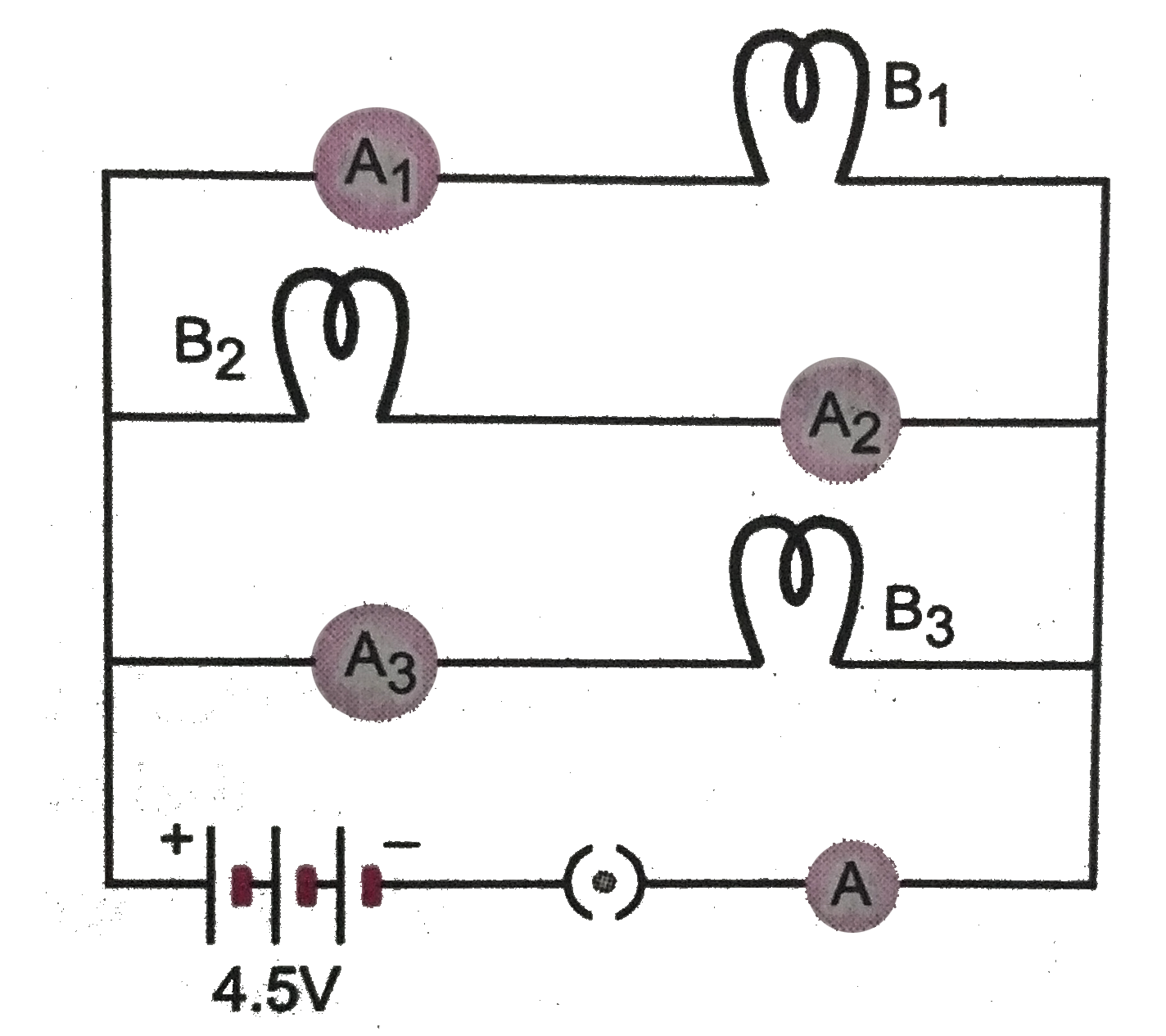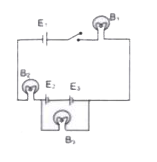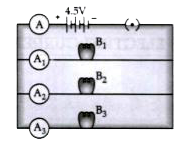B1,B2,B3 are three identical bulbs connected as shown in figure. Ammeters A1,A2,A3 are connected as shown. When all the bulbs glow, the current of 3A is recorded by ammeter A.
(i) What happens to the glow of the other two bulbs when bulb B1 gets fused?
(ii) What happens to the reading of A1,A2,A3 and A when the bulb B2 gets fused?
(iii) How much power is dissipated in the circuit when all the three bulbs glow together?

Resistance of combination of three bulbs in parallel
RReq=VI=4.53=1.5Ω
If R is the resistance of each wire, then
1Req=1R+1R+1R
or 1Req=3R
or R=3,Req=3×1.5=4.5Ω
Current in each bulb, I=VR=4.5V4.5Ω=1A
(i) When bulb B1 gets fused, the currents in B2 and B3 remain same I2=I)3=1A, so their glow remains unaffected.
(ii) When bulb B2 gets fused, the current in B2 becomes zero and currents in B1 and B3 remains 1A.
Total current I=I1+I2+I3=1+0+1=2A
Current in ammeter A1 = 1 A
Current in ammeter A2=0
Current in ammeter A3=1A
Current in ammeter A = 2A
(iii) When all the three bulbs are connected.
Power dissipitated P=V2Req=(4.5)21.5=13.5W
Topper's Solved these Questions
- ELECTRICITYBook:VK GLOBAL PUBLICATIONChapter:ELECTRICITYExercise:HOTS (HIGHER ORDER THINKING SKILLS)
Explore 10 Videos
- ELECTRICITYBook:VK GLOBAL PUBLICATIONChapter:ELECTRICITYExercise:SOME IMPORTANT NUMERICALS
Explore 12 Videos
- ELECTRICITYBook:VK GLOBAL PUBLICATIONChapter:ELECTRICITYExercise:NUMERICALS
Explore 2 Videos
- LIGHT-REFLECTION AND REFRACTIONBook:VK GLOBAL PUBLICATIONChapter:LIGHT-REFLECTION AND REFRACTIONExercise:PROFICIENCY EXERCISE (Long Answer Questions)
Explore 5 Videos
Similar Questions
B1,B2andB3 are three identical bulbs connected as shown in (fig. 3.46). When all the three bulbs glow, a current of 3A is recorded by the ammeter A.
(i) What happens to the glow of the other two bulbs when the bulb B1 gets fused ?
(ii) What happens to the readings of A1,A2,A3andA when the bulb B2 gets fused ?
(iii) How much power is dissipated in the circuit when all the three bulbs glow together ?
 .
.
View SolutionB1,B2andB3 are three identical bulbs connected as shown in (fig. 3.46). When all the three bulbs glow, a current of 3A is recorded by the ammeter A.
(i) What happens to the glow of the other two bulbs when the bulb B1 gets fused ?
(ii) What happens to the readings of A1,A2,A3andA when the bulb B2 gets fused ?
(iii) How much power is dissipated in the circuit when all the three bulbs glow together ?
 .
.
View Solution
Knowledge Check
What will happen to the other two bulbs if the bulb B3 gets fused?

AAll the bulbs will be fused.BOther bulbs will glow with same brightness.COther bulbs will glow with more brightness.DOther bulbs will glow with less brightness.Three batteries are connected as shown in figure. Reading of ideal ammeters A1,A2 & A3 are :
 A13A,0,13AB0.5A,0.5A & 1 A respectivelyCzero, 0.5A & zero respectivelyDzero, zero & 1A respectively
A13A,0,13AB0.5A,0.5A & 1 A respectivelyCzero, 0.5A & zero respectivelyDzero, zero & 1A respectivelyAn inductor L, a capacitor C and AC ammeters A1,A2 and A3 are connected in the circuit as shown. When the frequency of the oscillators is increased, then at resonant frequency, the reading of ammeter ?
 AA1 zeroBA2 zeroCA3 zeroDis same in A1,A2 and A3
AA1 zeroBA2 zeroCA3 zeroDis same in A1,A2 and A3
In the figure shown the readings of the ammeters A1andA2 are respectively.

View SolutionThree identical cells E1,E2,E3 and three identical bulbs B1,B2andB3 are connected as shown in the circuit.
Compare the brightness of the bulbs.

View SolutionB1,B2andB3 are the three identical bulbs connected to a battery of steady emf with key K closed. What happens to the brightness of the bulbs B1 and B2 when the key is opened?

View SolutionB1,B2andB3 are the three identical bulbs connected to a battery of steady emf with key K closed. What happens to the brightness of the bulbs B1 and B2 when the key is opened?

View SolutionIf the wattage of each bulb is 1.5 w , what will be the reading in the ammeter A when all the three bulbs glow simultaneously.

View Solution

